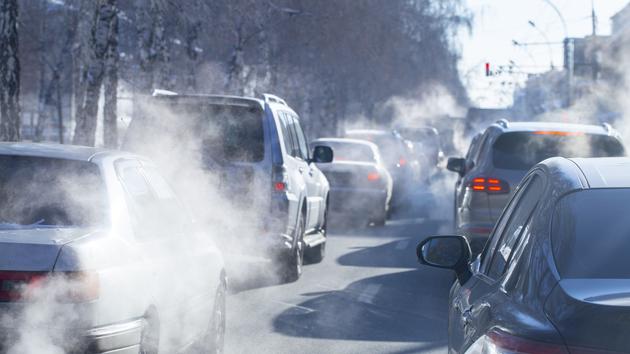For this October 14, National Air Quality Day in France, Airparif has issued a warning, because the fine particle threshold may be exceeded in the Paris region. And, despite the improvement of air quality in our country in recent years, this type of alert may be more frequent in the future. Because future indices will have to take into account a new opinion of the WHO (World Health Organization), which updated on September 22 its recommendations on the pollutant thresholds which dated from 2005. Two families are in the crosshairs: the fine particles and nitrogen oxides. Their concentrations have been revised downwards, because
"new epidemiological studies prove that there is an impact on health at very low doses"
, explains Dr Pierre Souvet, cardiologist and president of the Association santé environnement France.
Recent work by the WHO confirms
"that there is no minimum detectable threshold below which fine particles would have no effect"
, adds Matteo Redaelli, scientific project manager on air at ANSES (National Agency for Health Safety and the Environment).
To discover
Covid-19: the third vaccine dose, instructions for use
The WHO targets, as a priority, very small particles, invisible to the naked eye, called PM2.5 (whose diameter is less than 2.5 micrometers, which are 50 times smaller than the thickness of a strand of hair). The new recommendation divides the previous threshold by 2 (to 5 micrograms per cubic meter of air as an annual average) and slightly reduced the target for particles four times the size, called PM10.
"With these new thresholds, the entire population of Île-de-France would have been affected in 2020 by an overrun for PM2.5 and three quarters for PM10, instead of 95% and 50% of the population respectively. with the old concentrations,
details Pierre Pernot, engineer at Airparif, the agency that measures air quality in Île-de-France.
In addition, 2020 was a special year for air pollution, because of the Covid-19, which had reduced road traffic ”.
See also
Energy transition: dependent on coal and lignite, Poland under pressure
"The sources of fine particles are more diffuse than those of nitrogen oxides, even if in both cases road traffic plays an important role,"
explains the ANSES expert.
PM2.5 and PM10 come from a multitude of emission sources resulting from human activities, such as heating, transport, industry and agriculture.
In addition, they are the result of natural phenomena, such as desert sand, sea salts, volcanic eruptions, forest fires, pollens and transformation processes in the atmosphere. ”
In addition, the WHO has quadrupled its previous target for the annual concentration of nitrogen oxides (NO and NO2) in the air, most of whose emissions come from road traffic and a small part from industrial processes.
At the new WHO thresholds, 75% of the population in Île-de-France would be affected, according to Airparif, instead of 1% previously.
The same would apply to the entire population.
For nitrogen oxides, the renewal of the vehicle fleet should promote a marked drop in their concentrations.
Neurodegenerative diseases
The WHO has long considered that these pollutants have harmful effects on health.
They would cause 7 million deaths per year, generating cardiovascular, respiratory or cancer problems.
Just in France, because of fine particles (PM2.5), the number of premature deaths linked to air pollution is estimated between 40,000, according to Public Health France, and 97,000 per year, according to a study published in February, in
Environmental Research
by researchers at Harvard University.
Read also
Noise, this scourge that pollutes our lives
Without setting minimum values, the WHO warns against other pollutants, such as ultrafine particles or carbon soot. PM1 could cause neurodegenerative diseases, such as Alzheimer's disease. But already the new fine particle concentration thresholds recommended by the WHO will not be easy to assess.
"Current measuring equipment has error levels of a few micrograms per cubic meter of air
(almost the recommended threshold)
"
, explains Jean-Baptiste Renard, research director at the CNRS at the environmental physics and chemistry laboratory in Orléans.
The new objectives of the WHO will therefore lead to the development of techniques.
Already, Europe, which has initiated a review of its standards for pollutants in the atmosphere, should take into account the recommendations of the WHO.
Then the air agencies will adjust their indicators.
In the meantime, two complaints, in particular against France, are already examined by the European Court of Justice, about exceedances for fine particles and nitrogen oxides.
In addition, at the end of the year or at the beginning of 2022, the Council of State could impose sanctions on the government, because it did not take sufficient measures to enforce the old thresholds!
A test to purify the outside air
Aérophile, the SME which designed the Generali balloon which rises 150 meters above sea level in the André Citroën park in Paris, is proposing an experimental system to reduce the amount of fine particles in the air.
Called Para-PM, the system must capture fine particles by filtering the outside air, sucked into a machine at a rate of 30,000 m3 per hour.
A reaction called photocatalysis traps 99% of the particles, using a special paint and ultraviolet rays from the sun.
These devices have just been ordered to clean the air in the “athletes' village” in Saint-Denis, 150 meters from the A86 traffic, and to eliminate 15% of fine particles.

